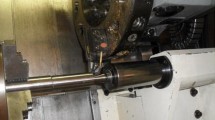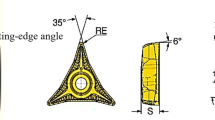Abstract
A commercially available insert has been used to turn an AISI 4340 steel at speeds placed between 325 and 1000 m/min. The flank wear was measured in connection to cutting time. This is to determine the tool life defined as the usable time that has elapsed before the flank wear has reached the criterion value.
It is shown that an increase in cutting speed causes a higher decrease of the time of the second gradual stage of the wear process. This is due to the thin coat layer which is rapidly peeled off when high-speed turning.
The investigation included the realization of a wear model in relation to time and to cutting speed. An empirical model has also been developed for tool life determination in connection with cutting speed.
On the basis of the results obtained it is possible to set optimal cutting speed to achieve the maximum tool life.
Similar content being viewed by others
References
Choudhury IA, Elbaradie MA (1999) Machinability assessment of inconel 718 by factorial design of experiment coupled with response surface methodology. JMPT 95:30–39
Dolinsek S, Sustarsic B, Kopac J (2001) Wear mechanisms of cutting tools in high speed cutting processes. Wear 250:349–356
Lim CYH, Lau PPT, Lim SC (2001) The effects of work material on tool wear. Wear 250:344–348
Zhao H, Barber GC, Zou Q (2002) A study of flank wear in orthogonal cutting with internal cooling. Wear 253:957–962
Dolinsek S, Kopac J (1999) Acoustic emission signals for tool wear identification. Wear 225:295–303
Hertzsch A, Kröger K, Truckenbrodt H (2002) Microtopographic analysis of turned surfaces by model-based scatterometry. J Int Soc Precis Eng Nano 26:306–313
Born DK, Goodman WA (2001) An empirical survey on the influence of machining parameters on tool wear in diamond turning of large single-crystal silicon optics. J Int Soc Precis Eng Nano 25:247–257
S.K. Choudhury SK, Appa Rao IVK (1999) Optimization of cutting parameters for maximizing tool life. Int J Mach Tools Manuf 39:343–353
Malz R, Brinksmeier E , Preub W, Kohlscheen J, Stock HP, Mayr P (2000) Investigation of the diamond machinability of newly developed hard Coating. Precis Eng 24:146–152
Choudhury SK, Kumar E, Ghosh A (1999) A scheme of adaptative turning operations. JMPT 87:119–127
Barry J, Byrne G (2001) Cutting tool wear in the machining of hardened steels. Part I: alumina/TiC cutting tool wear. Wear 247:139–151
Mari D, Gonseth DR (1993) A new look at carbide tool life. Wear 165:9–17
Ko DC, Kim DH, Kim BM (2002) Finite element analysis for the wear of Ti-N coated punch in the piercing process. Wear 252:859–869
Author information
Authors and Affiliations
Rights and permissions
About this article
Cite this article
Bouzid Saï, W. An investigation of tool wear in high-speed turning of AISI 4340 steel. Int J Adv Manuf Technol 26, 330–334 (2005). https://doi.org/10.1007/s00170-003-1991-5
Received:
Accepted:
Published:
Issue Date:
DOI: https://doi.org/10.1007/s00170-003-1991-5




